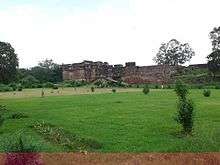Hammiradeva
| Hammiradeva | |
|---|---|
 Hammira's palace at the Ranthambore Fort | |
| king | |
| Reign | 1238-1301 |
Hammiradeva (r. c. 1283-1301), also known as Hammir Dev Chauhan in medieval vernacular legends, was an Indian king who ruled parts of present-day Rajasthan. He was the last king of the Chahamana (Chauhan) dynasty of Ranastambhapura (modern Ranthambore). He subjugated several neighbouring Hindu kings to expand his kingdom, which ultimately left him without allies against Alauddin Khilji, the Muslim Sultan of Delhi. Khilji's 1301 invasion of his kingdom resulted in his defeat and death.
Early life
Hammiradeva ascended the Chahamana throne sometime between 1283 and 1289 CE.[1] He was the successor of Jaitrasimha (also known as Jaitra Singh in vernacular legends). The name "Hammira" is a Sanskritized form of the Arabic title Amir.[2] Hammira Mahakavya, his biography by Nayachandra Suri, is a major source of information about his lfie.[3]
Military career
Paramaras
The Balvan inscription of 1288 CE mentions that Hammira captured the elephant force of Arjuna II, the Paramara king of Malwa.[4] The Hammira Mahakavya suggests that he also defeated Arjuna's successor Bhoja II.[5] He also subjugated the Paramara branch of Abu.[3]
Other Rajputs
He is said to have marched to Chitrakuta (Chittor). He raided several neighbouring Rajput territories, including Medapata (Mewar) and Vardhamanpura (modern Wadhwan).[3]
Delhi Sultanate
Hammira's wars with fellow Hindu Rajputs ultimately left him without any allies against the Delhi Sultanate. He successfully resisted invasions by Jalal-ud-din and Ala-ud-din's general Ulugh Khan. But he was killed in an invasion led by Ala-ud-din Khilji in 1301.[3]
In 1290 Jalal-ud-d Khilji attacked Hammira because of his rising power. Jalaludin's forces were defeated by Hammira. In 1296, Jalaludin was murdered by Allauddin Khilji. In 1297 Allauddin sent an army to plunder Gujarat, under the generalship of Ulugh Khan and Nusrat Khan. This army looted the temple of Somnath and its Shivalinga was broken into pieces and was being carried back to Delhi. Kanhad Dev Songara, ruler of Jalore attacked and defeated Ulugh Khan and captured the broken Shivalinga which was washed in Gangajal and the fragments were established in various temples in Jalore. Muhammad Shah, a neo-Muslim general in Khilji's army, helped Kanhad Dev Songara. In this war, neo-Muslims Muhammad Shah, Kamru, Yalchak and Barq attampted to assassinate Ulugh Khan but failed. Hence they took refuge with Hammira at Ranthambore. Under these circumstances, Hammira was justified in winning over Allauddin's enemies to his side. Bhoja afterward sought asylum in Alauddin's Camp.
Ulugh Khan went and apprised Allauddin who ordered him and Nusrat Khan to conquer Ranthambore. In 1299 they started out with 80,000 cavalry and a large infantry to attack Hammira. The Muslim governors tried to negotiate with Hammira and demanded for Muhammad shah and Kamru’s death, 10,000 gold coins, 300 horses, 4 elephants and the hand of Hammira’s daughter Devaladevi. The terms were rejected. Hammira's army repulsed the attack and killed Nusrat Khan. Ulugh Khan escaped and reached Delhi.
Khilji was taken aback by this defeat and wanted revenge. He finally came himself in 1301, and there was a long siege. Hammira was very well prepared, but Famin was a great hurdle to him. When the fort did not fall after repeated bloody skirmishes, Khilji resorted to diplomacy by taking advantage of dissatisfaction and treachery due to Famin and won over confidence of two of Hammira’s generals, Ratipal and Ranmal. Hammira was very suspicious but he heeded to his councillors who told him that sword is not always the best recourse. Ratipal and Ranmal were sent to the Khilji camp to negotiate. Khilji bribed these two generals of Hammira's army. Both the generals along with others slipped away and joined Alauddin’s camp. Ultimately war was declared. Hammira died in the war. Consequently, Ranthambore fell on July 10, 1301. Others who died with him were the brave Viram, the lord of Champa, Taka Gangadhara, Parmar Kshetrasinha, Rajda and Simha.
References
- ↑ G. N. Sharma 1970, p. 828.
- ↑ Romila Thapar 2005, p. 120.
- 1 2 3 4 Sailendra Nath Sen 1999, p. 336.
- ↑ Dasharatha Sharma 1975, p. 124.
- ↑ Ramesh Chandra Majumdar 1966, pp. 85-86.
Bibliography
- Dasharatha Sharma (1975). Early Chauhān Dynasties. Motilal Banarsidass. ISBN 978-0-8426-0618-9.
- G. N. Sharma (1970). Mohammad Habib and Khaliq Ahmad Nizami, ed. A Comprehensive History of India: The Delhi Sultanat (A.D. 1206-1526). 5. Indian History Congress / People's.
- Ramesh Chandra Majumdar (1966). The History and Culture of the Indian People: The struggle for empire. Bharatiya Vidya Bhavan.
- Romila Thapar (2005). Somanatha: The Many Voices of a History. Verso. ISBN 9781844670208.
- Sailendra Nath Sen (1999). Ancient Indian History and Civilization. New Age International. ISBN 9788122411980.
- The glory of Ranthambhor by Dr LS Rathore: Jodhpur university press, Jodhpur (India) First published in 1990
- Rajputs: Their Emergence and Heritage By S.R. Bakshi and Sri Kant Sharma; Page 143-145.